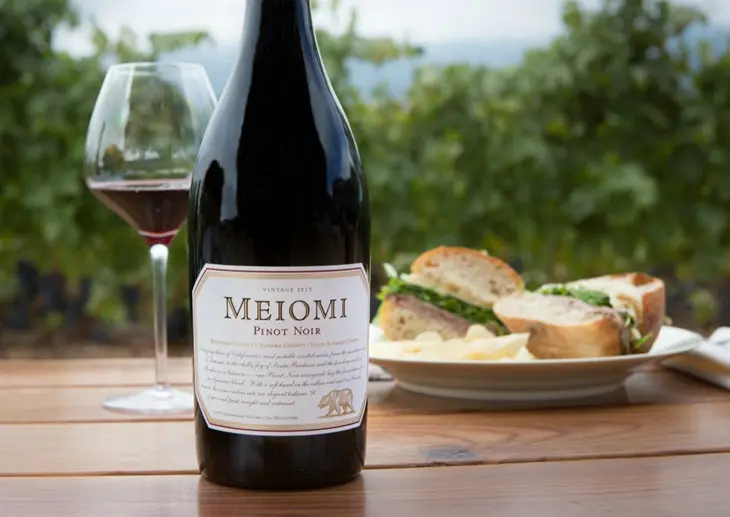Wine enthusiasts often seek detailed information about their favorite wines. One critical aspect is sugar content, which influences flavor, body, and overall enjoyment. Meiomi Pinot Noir, a popular choice among wine lovers, deserves a thorough examination. This article delves into the sugar content of Meiomi Pinot Noir, providing a comprehensive understanding of its impact on the wine’s profile.
Understanding Sugar in Wine
The Role of Sugar
Sugar in wine primarily comes from grapes. During fermentation, yeast converts grape sugars into alcohol and carbon dioxide. However, not all sugars are fermented. The remaining sugar is called residual sugar (RS). Residual sugar plays a significant role in the taste and balance of the wine. It contributes to sweetness, body, and mouthfeel.
Types of Sugar
Two main types of sugars are found in wine:
Glucose and Fructose: These are the primary sugars in grapes. They are easily fermentable by yeast.
Sucrose: Rarely found naturally in wine, sucrose can be added during winemaking in a process called chaptalization, though this practice is regulated and not common in quality wines.
Measuring Sugar Content
Sugar content in wine is measured in grams per liter (g/L). Different levels of residual sugar categorize wines into various styles:
Dry: Less than 4 g/L
Off-Dry: 4-12 g/L
Semi-Sweet: 12-45 g/L
Sweet: More than 45 g/L
Factors Influencing Sugar Content
Several factors influence the sugar content in wine:
Grape Variety: Different grape varieties have varying levels of natural sugars.
Climate: Warmer climates tend to produce grapes with higher sugar content.
Harvest Time: Late-harvest grapes have higher sugar levels.
Winemaking Techniques: Fermentation control and decisions like stopping fermentation early can affect residual sugar levels.
See Also: How Many Carbs in a Bottle of Meiomi Pinot Noir?
Meiomi Pinot Noir: An Overview
History and Background
Meiomi Pinot Noir is a blend of grapes from three coastal regions in California: Sonoma County, Monterey County, and Santa Barbara County. Launched by Joe Wagner in 2007, Meiomi quickly became popular for its approachable style and consistent quality.
Flavor Profile
Meiomi Pinot Noir is known for its rich, fruit-forward profile. Common tasting notes include:
Aroma: Red fruits like cherry and strawberry, with hints of vanilla and oak.
Palate: Smooth and silky with flavors of ripe berries, plum, and mocha.
Finish: Balanced with a touch of sweetness and moderate tannins.
Analyzing the Sugar Content in Meiomi Pinot Noir
Label Information
Wine labels can provide clues about sugar content, though exact figures are not always listed. Meiomi Pinot Noir labels typically indicate it is a fruit-forward wine, suggesting some level of residual sugar.
Residual Sugar in Meiomi Pinot Noir
Based on various sources and wine analysis, Meiomi Pinot Noir generally falls into the off-dry category. The residual sugar content typically ranges from 6 to 10 g/L. This level of residual sugar contributes to the wine’s smooth, approachable style and enhances its fruit flavors.
Comparison with Other Pinot Noirs
Comparing Meiomi Pinot Noir to other Pinot Noirs helps understand its unique position:
Dry Pinot Noirs: Typically have less than 4 g/L of residual sugar, resulting in a crisper, more tannic profile.
Off-Dry to Semi-Sweet Pinot Noirs: Meiomi falls in this range, offering a balance of sweetness and acidity.
Sweet Pinot Noirs: Rare, but would have significantly higher residual sugar content, often over 45 g/L.
Impact of Sugar Content on Meiomi Pinot Noir
Taste and Balance
The sugar content in Meiomi Pinot Noir plays a crucial role in its flavor profile:
Sweetness: The residual sugar adds a touch of sweetness, making the wine more approachable for a broad audience.
Body: Sugar contributes to the wine’s body, giving it a fuller, more rounded mouthfeel.
Balance: The balance between sugar, acidity, and tannins is key to Meiomi’s smooth and enjoyable taste.
Pairing with Food
The residual sugar in Meiomi Pinot Noir makes it versatile for food pairing:
Spicy Dishes: The slight sweetness can complement and balance spicy foods.
Rich Foods: Pairs well with richer dishes like roasted meats and creamy cheeses.
Fruit-Based Desserts: The fruity profile and residual sugar can enhance desserts with berries or chocolate.
Consumer Preferences
Meiomi Pinot Noir’s sugar content aligns with modern consumer preferences. Many wine drinkers enjoy wines that are fruit-forward and slightly sweet, making Meiomi a popular choice.
The Science Behind Residual Sugar
Fermentation Process
Understanding the fermentation process helps explain residual sugar levels:
Initial Fermentation: Yeast converts most sugars into alcohol.Temperature and yeast strain can affect how much sugar remains.
Arrested Fermentation: Winemakers can stop fermentation early to retain some sugar. This can be done by chilling the wine or adding sulfur dioxide.
Blending: Combining different lots of wine can balance sugar levels.
Winemaking Decisions
Winemakers make several decisions that impact sugar content:
Grape Selection: Choosing riper grapes increases initial sugar levels.
Fermentation Control: Monitoring and controlling fermentation can influence residual sugar.
Aging: Barrel aging can concentrate flavors and subtly affect perceived sweetness.
Analytical Techniques
Modern winemaking uses various techniques to analyze and control sugar content:
Refractometers: Measure sugar levels in grape juice before fermentation.
Hydrometers: Monitor sugar conversion during fermentation.
Chromatography: Detailed analysis of residual sugars in the finished wine.
Conclusion
Meiomi Pinot Noir’s sugar content is a defining feature of its appealing flavor profile. With residual sugar levels typically between 6 and 10 g/L, it offers a balanced, fruit-forward taste that appeals to many wine enthusiasts. Understanding the role of sugar in wine helps appreciate the craftsmanship behind Meiomi Pinot Noir and enhances the overall wine experience.
By exploring the intricate details of sugar content and its impact, wine lovers can deepen their appreciation for Meiomi Pinot Noir and make informed choices in their wine selections. Whether enjoyed on its own or paired with a variety of foods, Meiomi Pinot Noir stands out as a versatile and delightful wine, thanks in part to its carefully balanced residual sugar content.


